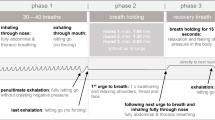Abstract
Two experiments were conducted to test the proposal that laughter is a pain antagonist. In Experiment I, thresholds for pressure-induced discomfort of 20 male and 20 female subjects were measured after each subject listened to a 20-min-long laughter-inducing, relaxation-inducing, or dull-narrative audio tape or no tape. Discomfort thresholds were higher for subjects in the laughter- and the relaxation-inducing conditions. In Experiment II, 40 female subjects were matched for pressure-induced discomfort thresholds. Their discomfort thresholds were measured after they listened to a laughter-inducing, interesting narrative, or uninteresting narrative audio tape, completed a multiplication task, or experienced no intervention. Discomfort thresholds increased for subjects in the laughter-inducing condition. Laughter, and not simply distraction, reduces discomfort sensitivity, suggesting that laughter has potential as an intervention strategy for the reduction of clinical discomfort.
Similar content being viewed by others
References
Beecher, H. D. (1959).Measurement of Subjective Responses, Oxford, New York.
Cogan, R., and Kluthe, K. B. (1981). The role of learning in pain reduction associated with relaxation and patterned breathing.J. Psychosom. Res. 25: 535–539.
Cousins, N. (1976). Anatomy of an illness (as perceived by the patient).N. Engt. J. Med. 295: 1458–1463.
Cox, D. J., Freundlich, A., and Meyer, R. G. (1975). Differential effectiveness of elec-tromygraphic feedback, verbal relaxation instructions, and medication placebo.J. Consult. Clin. Psychol. 43: 892–898.
Craig, K. D., and Coren, S. (1975). Signal detection analyses of social modeling influences on pain expressions.J. Psychosom. Res. 19: 105–112.
French, A. P., and Tupin, J. P. (1974). Therapeutic application of a simple relaxation method.Am. J. Psychother. 28: 282–287.
Johnson, J. E., and Leventhal, H. (1974). Effects of accurate expectations and behavioral instructions on reactions during a noxious medical examination.J. Person Soc. Psychol. 29: 710–718.
McGhee, P. (1979).Humor: Its Origin and Development, Freeman, New York.
Melamed, B. G., and Siegel, L. J. (1975). Reduction of anxiety in children facing hospitaliza-tion and surgery by use of filmed modeling.J. Consult. Clin. Psychol. 43: 511–521.
Melzack, R., and Wall, P. D. (1965). Pain mechanisms: a new theory.Science 150: 971–979.
Sosa, R., Kennell, J., Klaus, M.et al. (1980). The effect of a supportive companion on perinatal problems, length of labor, and mother-infant interaction.N. Engl. J. Med. 303: 597–600.
Walsh, J. J. (1928).Laughter and Health, Appleton, New York.
Author information
Authors and Affiliations
Rights and permissions
About this article
Cite this article
Cogan, R., Cogan, D., Waltz, W. et al. Effects of laughter and relaxation on discomfort thresholds. J Behav Med 10, 139–144 (1987). https://doi.org/10.1007/BF00846422
Accepted:
Issue Date:
DOI: https://doi.org/10.1007/BF00846422




